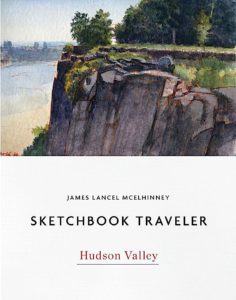As civil unrest sweeps through our cities, we think of friends and loved-ones who continue to shelter in place. Immobilized for the time being, we can revisit destinations, near and far. join me in celebrating the joys of Quaranteam travel, the hope that these diversions might inspire us to value things we had taken for granted, to draw strength, wisdom and compassion from deeper engagements with nature.

The Hudson Near Fort Miller. Friday May 29, 2015
Image and text were featured in the exhibition James McElhinney. Discover the Hudson Anew, curated by Laura Vookles. Hudson River Museum. Yonkers, New York. September 13, 2019 to February 16, 2020. Published also as a limited-edition in Hudson Highlands. North River Suite Volume One. Needlewatcher Editions. New York. 2018.
“Fort Miller is a small village in the township of Argyle and Washington County; thirty-seven miles north pf Albany and thirteen south of Sandy Hill. The great post-road from Albany crosses the bridge at this place, passing from the west to the east bank of the Hudson. There are some considerable falls and rapids near tis place; the latter of which were about eight feet in height when this view of the river was taken. Over these falls it is by no means unusual for raftmen to precipitate their rafts, whenever the state of the lumber-market at Albany is such as to offer inducement adequate to the risk; the usual course is by a short canal entering the Hudson at a short distance above and below the bridge, which avoids the falls altogether. General Putnam, when a major in the army, is said to have been the first to have tried this daring achievement. A part of Indians came suddenly upon him, as he lying near the rapids with a bateau and five men. A moment only was allowed for his determination, as to the best mode of conduct; already one of his men was stretched out dead at his feet, the balls flew in showers about his head; trusting to Providence he pushed off his boat, which by the force of the rapids was soon carried out of the reach of musket-shot…and although eddies whirled around him…he ultimately succeeded in rescuing himself from imminent destruction, to the terror and admiration of is superstitious enemies, who attributed his escape to the assistance of some supernatural power.”
–John Agg. Hudson River Port Folio. 1820

View Near Fort Miller. William Guy Wall. Hudson River Port Folio. Printed by John Hill for Henry Megary, 1822. Collection Metropolitan Museum of Art. (Reproduced under Fair Use, etc.)
Preparing to produce a series of prints with accompanying texts, Irish painter William Guy Wall journeyed with travel-writer John Agg from New York City to the Adirondacks in 1820. Fort Miller had been constructed along the Hudson during the French and Indian War to protect a river crossing, or carrying-place above a small set of falls. The region was famous in the prelude to Burgoyne’s surrender at Schuylerville, four days and two years before Cornwallis laid down his arms at Yorktown. Burgoyne’s failure brought France into an alliance with the newly-formed United States. The area between the Mohawk River and Lake Champlain would soon become more well-known through the Leatherstocking novels of James Fenimore Cooper. Now, as then Fort Miller is a pleasant hamlet on the banks of the Hudson, next to one of the locks on the Champlain Canal that links tidewater Hudson to Lake Champlain. Architectural historian, novelist, and raconteur James Howard Kunstler has for many years been a plein-air painting companion. On May 29, 2015, we piled into his pickup truck and headed off in search of a motif. Arriving at Clark’s Mills, discouraged by new fences and threatening signage, we moved upriver to Fort Miller. A pair of dredging-barges ride on the stream, cranes at rest, cables slack, these dystopic gatecrashers, disrupting pastoral harmony with rusting dissonance remind us that The Hudson is a going concern, a working waterway that mingles muscle with beauty.

Fort Miller Rapids. Benson J. Lossing. The Hudson from the Wilderness to the Sea. 1866
Check out April 2020 Quaranteam Traveler Dispatches

(A preview of SKETCHBOOK TRAVELER by James L. McElhinney (c) 2020. Schiffer Publishing).
Copyright James Lancel McElhinney (c) 2020 Texts and images may be reproduced (with proper citation) by permission of the author. To enquire, send a request to editions@needlewatcher.com
